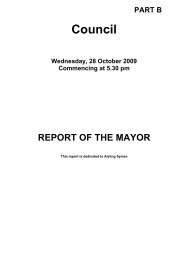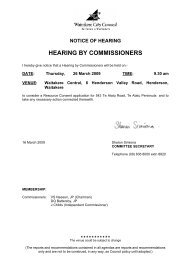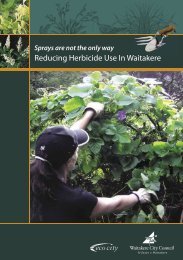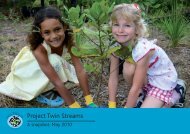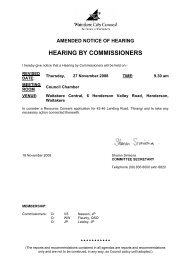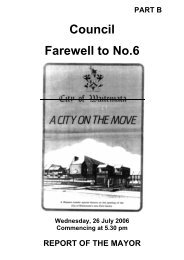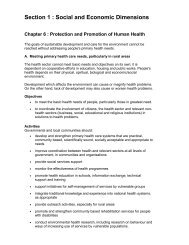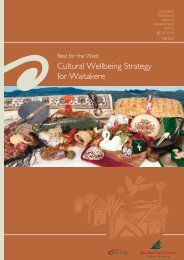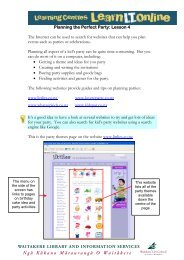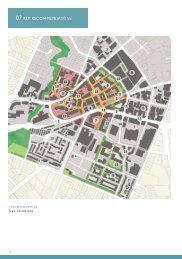The Waitakere Way - Looking Back, Going Forward - Auckland Council
The Waitakere Way - Looking Back, Going Forward - Auckland Council
The Waitakere Way - Looking Back, Going Forward - Auckland Council
Create successful ePaper yourself
Turn your PDF publications into a flip-book with our unique Google optimized e-Paper software.
PAGE 18getting together and the statutory agencies and non-statutory, identifying the needs, going toCity <strong>Council</strong>. Tim Shadbolt was in the <strong>Council</strong> at that time, and we managed to get help. <strong>The</strong>ywere putting that new linkage road down Lincoln Road, and into Central Park Drive, and therewas a house that was being moved and they moved that up onto the Park and gave it to us! Itwas very generous on behalf of the <strong>Council</strong>. It’s like we identified the need, had publicmeetings, big public meetings, heaps of interest, and got the <strong>Council</strong> along and said we needa Community Centre. We need it. We want it. And <strong>Council</strong> got there and said, Okay! So that’show that began for the Community.Pioneering relationships‘In the ‘80s, it was very ‘pioneering’, but also Services were very generalized. <strong>The</strong>y began tobecome more specifically client population focused. Like, the mushrooming of Women’sRefuge or Sexual Abuse Services or Family Violence Services, whereas at one time theWomen’s Centre, say, would probably do everything. Pioneering - people sort of carving theirterritory. I remember that quite strongly. <strong>The</strong>re was a very territorial base in Community SocialServices. I know when the Sexual Abuse Centre first started, even when we did a lot ofconsultation, there was a lot that was jealously guarded, and it still is. I think that theCommunity sector in <strong>Waitakere</strong> jealously guards who is acceptable and who is not, and howpeople become acceptable. <strong>The</strong>y have to prove themselves. <strong>The</strong>y have to become involvedin the network. <strong>The</strong>y’ve got to be willing to put in time to develop relationships before they’retrusted.‘But back then, I think we had the potential for rifts to occur, and rifts did begin to occur. And alot of us put quite a lot of energy into ‘Let’s sit down and talk about it’. And we did a lot of thatin the early days. So the potential for rifts was there, and they didn’t happen because we didthings like the ‘co-gender dialogue’. We did things like developing WAVES or WAVAN, whichwere quite unique in those times. Everybody that was involved would get together. Iremember that we had quite a few facilitated or processed meetings. We’d talk about difficultthings. We’d talk about some of the myths that were developing about Social Services, orsome of the truths as well. So that we were debunking them or working our way through it bitby bit. So it was quite a tough time.Early networks, government departments, and WADCOSS‘What predated WADCOSS was the West <strong>Auckland</strong> Resource Network. That was really thefirst attempt that I’m aware of – to bring a wide range of agencies together. It was verydeliberately done in the recognition that there were a lot of people in Government service thatcouldn’t really speak out themselves. We’re not talking about a situation when debate ordissent or anything was encouraged’.‘When you look back, some of the early meetings of Wadcoss were, themselves, quiteinnovative in the way they tried to do things. What we were doing of course is trying to findany kind of a way to make people come. It’s not as if there was an instant agreement that thiswas the best thing since sliced bread. In setting up any kind of organisation where you try andget people to commit to doing things, you always have a struggle to get them’.‘We set up Wadcoss on the model of District <strong>Council</strong>s of Social Services, which was alreadyreasonably strong in existence in other areas. I remember having meetings where there were30 or 40 people there. Everybody there would stand up for about 3 or 4 minutes, and talk.You could have these meetings which would go on interminably. Some of them were prettycool. <strong>The</strong>y still work like that. Over the last couple of years they’ve resurrected that ‘lunchtimeforum thing.’ That role was dropped for a while. It’s a very valuable thing to have. <strong>The</strong>re’s alsoother ways. <strong>The</strong>re’s a whole multitude of networks now where previously Wadcoss had veryfew’.‘WADCOSS gave the protection for public servants to raise issues. Issues could be raisedthrough Wadcoss as a neutral broker. Issues that couldn’t be raised directly by publicservants….’



